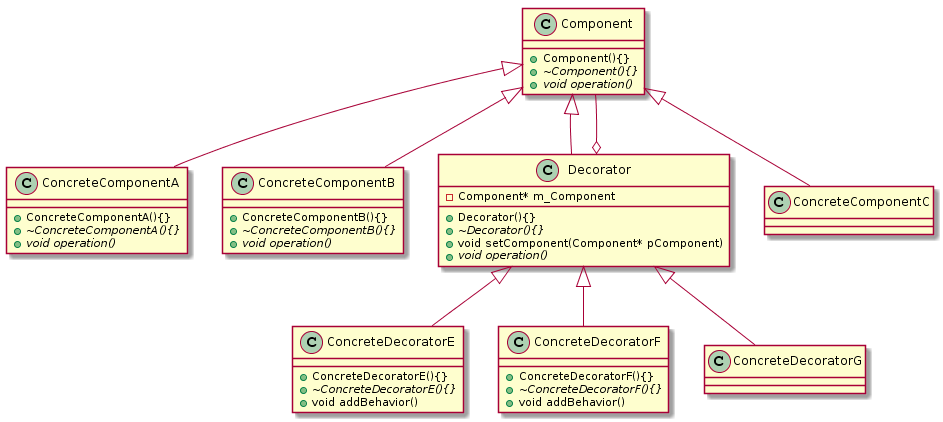装饰模式是一种经典的类功能扩展模式,其精髓在装饰类使用继承加聚合的方式获得接口和要实现对象,然后通过自己实现扩展接口
作用
装饰模式通过装饰类动态地将责任附加到对象上,若要扩展功能,无需通过继承增加子类就能扩展对象的新功能,提供了比继承更有弹性的替代方案,避免了子类数量膨胀带来的系统臃肿。
类视图

代码实现
class Component
{
public:
Component(){}
virtual ~Component(){}
virtual void operation() = 0;
};
class ConcreteComponentA : public Component
{
public:
ConcreteComponentA(){}
~ConcreteComponentA(){}
void operation()
{
fprintf(stderr, "ConcreteComponentA's operation!
");
}
};
class ConcreteComponentB : public Component
{
public:
ConcreteComponentB(){}
~ConcreteComponentB(){}
void operation()
{
fprintf(stderr, "ConcreteComponentB's operation!
");
}
};
class Decorator : public Component
{
public:
Decorator() :mComponent(NULL){}
virtual ~Decorator(){}
virtual void operation()
{
if (mComponent)
mComponent->operation();
}
virtual void setComponent(Component* pComponent)
{
mComponent = pComponent;
}
protected:
Component* mComponent;
};
class ConcreteDecoratorE : public Decorator
{
public:
ConcreteDecoratorE ();
virtual ~ConcreteDecoratorE ();
virtual void addBehavior()
{
mComponent->operation();
fprintf(stderr, "ConcreteDecoratorE's addBehavior!
");
}
};
class ConcreteDecoratorF : public Decorator
{
public:
ConcreteDecoratorF ();
virtual ~ConcreteDecoratorF ();
virtual void addBehavior()
{
operation();
fprintf(stderr, "ConcreteDecoratorF's addBehavior!
");
}
};
int main()
{
ConcreteComponentB *pComponent = new ConcreteComponentB();
ConcreteDecoratorF decorator;
decorator.setComponent(pComponent);
decorator.addBehavior();
}